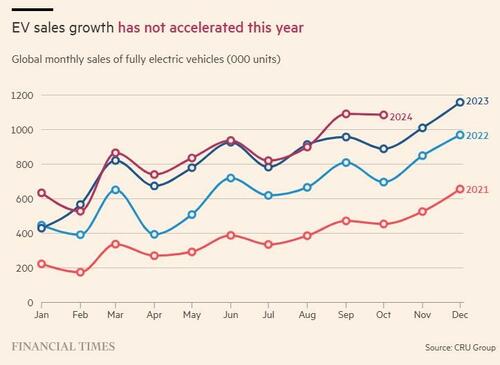Now that the shine and allure of being the 'new fad' and government subsidies are starting to wear off - along with a marketplace full of super-saturated competition and robust supply - EVs simply aren't selling.
That was the topic of a new FT report that claims the auto industry’s shift toward EVs, once seen as essential, is now facing serious challenges.
It cites for example that Northvolt, Europe’s top battery producer, filed for bankruptcy last week, casting doubt on the region’s industrial strategy. Additionally, Stellantis announced the closure of its UK van plant, risking 1,100 jobs, while Volkswagen and Ford also warned of significant job cuts and plant closures due to weaker-than-expected EV demand.
And as we noted earlier this week, GM is taking a $5 billion charge to reorganize its Chinese business.
Now the U.S. risks falling further behind in its green transition as EV adoption lags and President-elect Trump’s plans to cut subsidies threaten progress. While President Biden aims for EVs to make up half of new car sales by 2030, they accounted for just 10% last year, according to FT.
And carmakers have scaled back production plans, with U.S. EV output expected to drop by 50% and European plans by 29% next year, according to Bernstein. By 2025, EV market share is projected to reach 23% in Europe and 13% in the U.S.
FT reported that the slow growth of EV adoption globally stems from high upfront costs, concerns about range and charging infrastructure, and fading energy price advantages due to geopolitical tensions.
Rising interest rates have further increased leasing costs. In Europe, EV prices have climbed from €40,000 in 2020 to €45,000 today, far above the €20,000 many consumers are willing to pay.
Meanwhile, inconsistent government subsidies have led to uneven adoption, with Germany and France cutting incentives, prompting concerns about declining EV sales and job losses in the auto industry.
China, by contrast, has successfully integrated its EV strategy, leveraging state-backed initiatives, subsidies, and a robust supply chain to dominate the market. More than half of new cars sold in China are now EVs or plug-in hybrids, aided by competitive pricing and innovative in-car technology.
Europe, constrained by free-market principles, cannot match China’s state-driven model and has resorted to imposing tariffs on Chinese EV imports. Despite setbacks, automakers in Europe remain optimistic, planning affordable EV models under €25,000 to meet stricter emissions targets, aiming to balance cost reduction with growing consumer interest in electric technology.
Bernstein analyst Daniel Roeska concluded: “The EV production forecast for 2025 has seemingly only gone one way — down.”
